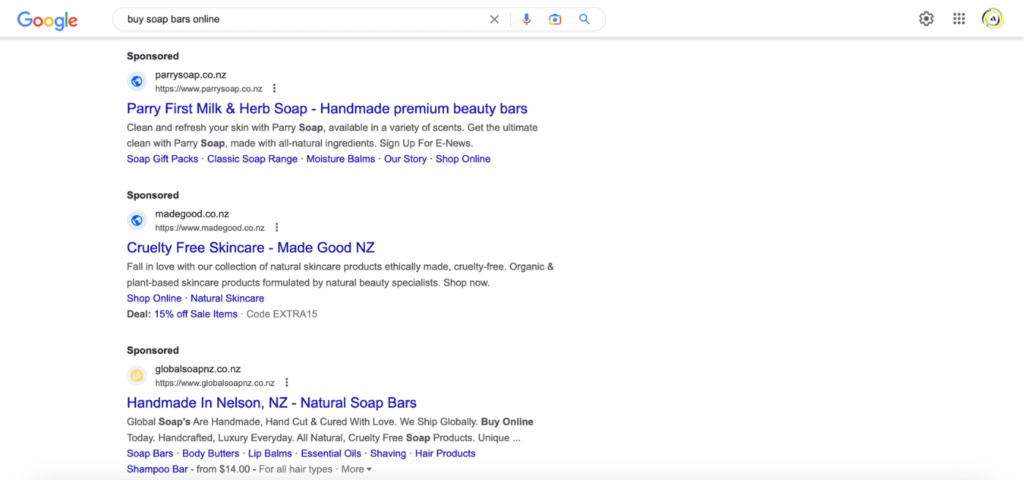How to Use Pay-Per-Click (PPC) Advertising to Drive Sales

Pay-per-click or PPC advertising is a digital marketing approach that operates on a simple principle: advertisers only pay when users click on their ad. This cost-efficient model provides a considerable advantage, particularly for businesses targeting potential customers who have already expressed interest in similar products or services.
PPC ads, also called “paid ads,” are strategically placed on search engine results pages (SERPs) when a user’s search query matches a keyword or phrase associated with your business. To illustrate this, consider that you’re running a business specialising in producing handmade, artisanal soap bars. You’ve opted to advertise on popular search engines like Google or Bing. When a prospective customer types in a query like “buy soap bars online,” the search engine’s algorithm triggers your PPC ad due to the relevance of the keywords. Your ad then appears prominently on the SERP, increasing the visibility of your business to the searcher.
Once the user clicks your ad out of interest, they’re redirected to your website. Here, they can delve deeper into what you offer, explore various soap options, read about the unique features of your handmade soaps, and, ultimately, make a purchase.
Platforms like Google Ads allow you to create PPC campaigns with various ad formats, such as search ads, display ads, shopping ads, video ads, and more, each catering to different types of user engagement. For example, search ads are text-based and appear on Google SERPs, while display ads are typically image-based and show up on Google’s partner websites.
Despite its apparent simplicity, PPC advertising is a nuanced strategy that requires careful planning and execution to drive significant sales effectively. It isn’t as simple as setting up an ad and waiting for the clicks to roll in. To create successful PPC campaigns, consider the following essential tips:
1. Master Keyword Selection
Keyword selection is one of the most critical elements in creating a successful pay-per-click (PPC) advertising campaign. It is the process of identifying and selecting the keywords that potential customers are likely to use when searching for products or services similar to your business. When chosen correctly, these keywords can ensure your ads are displayed to the most relevant audience, thereby increasing the likelihood of conversions.
Suppose you have an online store specialising in handmade, artisanal soap bars. Appropriate keyword selection begins with basic brainstorming of relevant terms, such as “handmade soap,” “artisanal soap,” and “organic soap.” You can then expand and refine the terms using keyword research tools like Google’s Keyword Planner, which suggests related keywords and provides crucial metrics like search volume, competition, and trends. You must focus on search intent, paying attention to terms indicating buying intent, such as “buy handmade soap online.”
Long-tail keywords, such as “handmade lavender and chamomile soap,” are included for their specificity and potential for high conversion rates, despite lower search volumes. Finally, if relevant, local keywords like “handmade soap in Auckland” are added to attract location-specific traffic. This ongoing process results in a diverse mix of general, specific, long-tail and local keywords continually reviewed and updated based on performance data and market changes.
Read Selecting the Perfect Keywords for Successful PPC Campaigns for a detailed guide.
2. Craft Effective Ad Copy
Creating compelling ad copy is critical to successful pay-per-click (PPC) advertising. The ad copy is your potential customer’s first interaction with your brand, so it must be engaging, persuasive, and drive action. It’s not merely about writing words that fit the ad space; it’s about understanding your audience’s needs and presenting your offering in a way that resonates with them.
For the handmade, artisanal soap store example, creating compelling ad copy involves incorporating selected keywords into the text, such as “Buy Artisanal Soap Online” or “Experience our Organic, Handmade Soaps.” The ad copy should highlight the store’s unique selling propositions, like using all-natural ingredients, offering a variety of unique scents, or having excellent customer reviews.

A clear call to action, like “Shop now and discover your perfect scent!” should include relevant ad extensions, such as location or promotional offers. The performance of the ad copy should be continuously monitored and refined based on click-through and conversion rates to ensure optimal effectiveness.
Read Creating Effective Ad Copy: 7 Strategies to Win Kiwis Hearts for a detailed guide.
3. Determine a Budget
Budgeting is crucial to running successful pay-per-click (PPC) advertising campaigns. Without a well-defined budget, you may end up overspending or not investing enough to see significant results. A thoughtful budget considers the digital marketing budget, the business’s goals, and the potential return on investment (ROI).
Setting a budget for the PPC campaign for the handmade soap store in our example involves various steps. Firstly, an overall advertising budget, let’s say $1000 per month, needs to be established. Next, consider the customer lifetime value (CLV) and the cost per acquisition (CPA); for instance, a CPA of $20. You can then use this information to set the maximum cost per click (CPC), which in this case would be $4, calculated from the CPA and the ad’s conversion rate.
The budget would then be allocated across different campaigns, perhaps favouring those targeting high-intent keywords or promoting a new product line. Finally, the budget allocation would be continually monitored and adjusted based on the performance of the individual campaigns.
4. Monitor Your Results
Performance tracking is an essential component of successful pay-per-click (PPC) advertising. It involves continuous monitoring and analysing your campaign data to understand what’s working and what’s not, so you can make informed decisions and continually optimise your campaigns for better results.
There are several key metrics you should monitor in your PPC campaigns:
- Clicks: The number of times people have clicked on your ads.
- Impressions: The number of times your ads have been displayed.
- Click-Through Rate (CTR): The ratio of ad clicks to impressions. If an ad gets 5 clicks from 100 displays, the CTR is 5%.
- Average Cost Per Click (CPC): The average amount you pay for each click.
- Conversions: The number of desired actions (purchases, in this case) resulting from your ads’ clicks.
- Cost Per Acquisition (CPA): The average amount you pay for each conversion.
Firstly, conversion tracking needs to be established to track purchases resulting from the ads. Key metrics, like the ones defined above, are then analysed. For instance, an ad with a high CTR and low CPC would indicate effective ad copy and keywords. These insights inform data-driven decisions, such as allocating more budget to an ad with a lower CPA and higher conversion rate. This continuous monitoring and adjustment process optimises the campaigns based on ongoing performance data.
To maximise the productivity of your PPC ads even further, consider delving into the following strategies, each of which can play a critical role in enhancing the overall success of your campaigns:
1. Employ Powerful Calls to Action (CTAs): CTAs are critical in guiding your audience towards a specific action. A compelling CTA could be the difference between a customer proceeding to your website or continuing their search elsewhere. It’s essential that your CTA is clear, enticing, and directs the user towards the desired action; this could range from a simple “Discover our unique scents now!” to “Shop now for all-natural artisanal soaps!” These CTAs can entice potential customers to click on the ad and browse the soap offerings.
2. Use of Negative Keywords: Negative keywords help ensure your ads are not displayed for irrelevant searches. For instance, if the handmade soap store doesn’t offer free samples, adding “free” as a negative keyword will prevent ads from appearing in searches like “free handmade soap samples.” This helps you focus your budget on searches more likely to result in sales.
3. Utilise Ad Extensions: Ad extensions can provide additional relevant information that complements your primary ad copy. For the handmade soap store, this might include the store’s physical location, phone number, or customer reviews. These extensions can make the ads more appealing and informative to potential customers, increasing their likelihood of engaging with the ads.
4. Optimise the Landing Page: The landing page is where users are directed after clicking on your ad. Your landing page should load fast, be aesthetically pleasing, be easy to navigate, and provide relevant information about the various soap offerings. It should also align with the ad copy and keywords and offer a seamless purchasing process.
The handmade soap store can enhance the effectiveness of its PPC ads, attract more potential customers, and drive sales, thus contributing to the store’s growth.
Never Miss a Thing!
Subscribe to our blog for the latest expert tips and digital marketing resources.





